#Sarmizegetusa
Text
Amfiteatrul din Ulpia Traiana Sarmizegetusa, „restaurat” cu tribune metalice
Lucrările de restaurare care cuprind Amfiteatrul din Ulpia Traiana Sarmizegetusa se apropie de final, dar proiectul are șanse minime de a fi realizat în termenul prevăzut, decembrie 2023. Monumentul antic este dotat în aceste zile cu tribune metalice.
Turiștii care vizitează Ulpia Traiana Sarmizegetusa, rămășițele primului oraș antic înființat de romani pe teritoriul Daciei, aflate în județul…
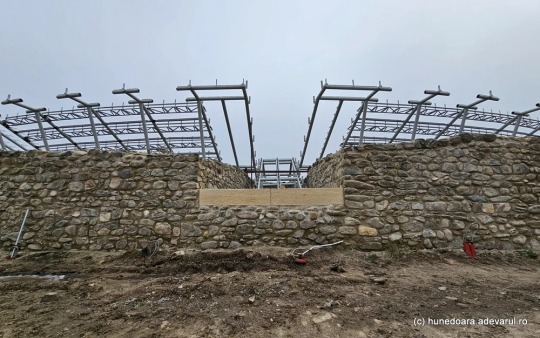
View On WordPress
#amfiteatru sarmizegetusa#dacia romana#HUNEDOARA#imparatul traian#imperiul roman#restaurare sarmizegetusa#roma antica#stiri din galati#stiri galati#tribune metalice#ulpia traiana sarmizegetusa
1 note
·
View note
Text
The Sarmizegetusa Regia
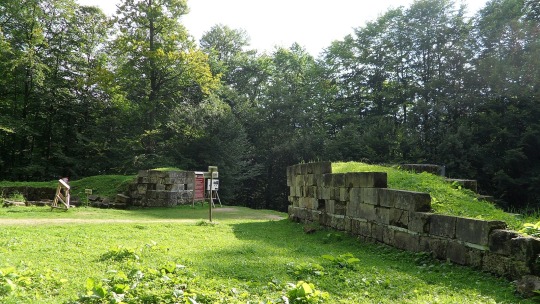
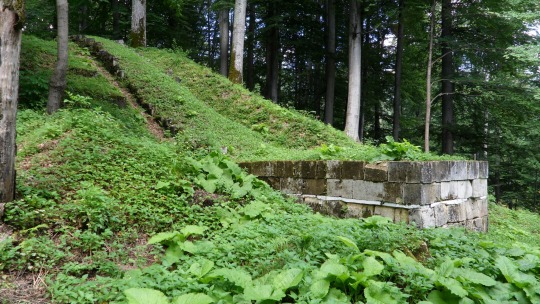
Did you know that Romania is home to one of the oldest fortified settlements in Europe? The Sarmizegetusa Regia, located in the Carpathian Mountains, was the capital of the Dacian Kingdom and served as the residence of King Decebalus.
This ancient site, dating back to the 1st century BC, features impressive fortifications, megalithic walls, and a complex network of tunnels. Its strategic location made it a formidable stronghold against Roman invasions.
Photo by Cosmin Stefanescu via Wikimedia Commons
#romania#eastern europe#europe#history#dacia#dacian kingdom#romanian history#sarmisegetusa regia#fortified#fortifications#decebalus#carpathians#carpathian mountains#roman empire
61 notes
·
View notes
Text

Dacian gold bracelets, uncovered near Sarmizegetusa Regia, Romania, 1st century BC
from The National Museum of Romanian History
145 notes
·
View notes
Note
Quick question, what’s the deal with the Eldest and Kupala? Did they strike a deal with the devil-style bargain, or was it something else?
More or less, yeah! The story goes that the Eldest never really felt at home in Enoch, and wandered until they reached the Carpathians, where they felt a connection to the soil and land there. It's ambiguous whether they were reacting to the land itself, or to Kupala, bound beneath it.
Either way, they sensed Kupala's presence and just... made contact. Kupala wanted to be freed from the prison the Garou had basically put it in, and the Eldest wanted knowledge, and the Eldest offered to try to free Kupala to get that knowledge. They didn't quite succeed, not able to sever the final connection between Kupala and the Carpathians, but they did help, and Kupala gave them knowledge in return. This is generally accepted to be in the form of Koldunic sorcery, which technically would make it a form of infernalism, although only in the sense that it was passed down from a demon and not in the sense of dealing with them directly (Koldunic sorcery requires exchanges with spirits, which aren't actually demons).
This didn't work out great, since during the Baali War, the Salubri methuselah Samiel did, in fact, sense infernal taint on the Eldest, and attacked them. This led to both their deaths, except you can't really kill the Eldest. This is where the Dracon getting surprise!pregnant with his sire comes in! After the Dracon gave birth, he took the baby Eldest to Yorak at the Cathedral of Flesh, and at some point was transferred to Sarmizegetusa under the care of Damek Ruthven, Kupala whispering to the Eldest all that time.
Either way, Kupala has shaped the Tzimisce clan almost as much as the Eldest has. The clan curse of being tied to soil or Domain relates back to the Eldest being tied to Kupala's lands by Caine's curse, Kupala is referenced in several Koldunic rituals and powers, Kupala's Sacred Fire-Flower was one of the most important parts of creating the Vaulderie ritual, et cetera. (Kupala might have also influenced the Cathedral to eat Yorak.) And they're not actually the only clan to be heavily influenced by Kupala - as the 'Root of All', it directly influenced House Tremere to set up the chantry of Ceoris in the 980s, and to begin the process of using Tzimisce vitae to become Cainites in the following decade. Perhaps it was curious to see what it could make out of Tzimisce blood itself, and used the Tremere mages as a way to do that?
Kupala, incidentally, is referenced in the name Kupala Night, an actual Slavic pagan celebration for Midsummer, referencing the birth of the sun, Kupalo, and the shortest night. During the medieval period, 'Kupala Night' gave rise to a deity of the same name, although the celebration is believed to have existed much earlier than the deity it references. 'Kupala's Night' as celebrated by Tzimisce in the World of Darkness presumably refers to the demon itself, not a feminine deity of sun and water. The Fire-Flower used for the Vaulderie is presumed to be a reference to the actual tradition of trying to find a fern flower, which is said only to flower during the midsummer.
(Kupala Night also inspired Mussorgsky's Night on Bald Mountain, the Fantasia sequence of which scared me so much as a child I didn't realise it was followed by Ava Maria until I was in my twenties :D)
For more lore fun, a Romanian Youtuber called The Old Country has a deep dive series into Tzimisce lore and specifically Kupala! Everything is in the playlist here, highly recommended.
28 notes
·
View notes
Photo
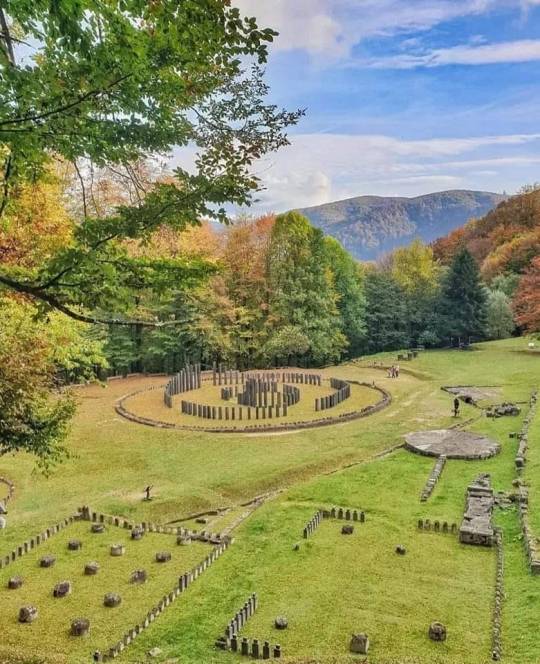
~ “Sarmizegetusa Regia - the capital of ancient Dacia (modern Romania) more than two millenniums ago.” ~
7 notes
·
View notes
Photo
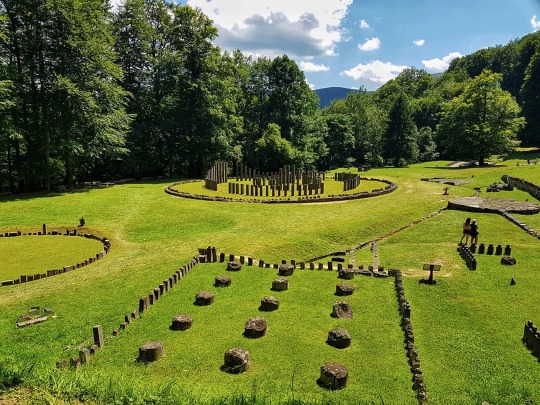
Sarmizegetusa Regia . . . . . #history #historia #temple #temples #ancient #ancienthistory #dacic #romania🇹🇩 #romania #carpathianmountains #monument #monumental #sunny #sunnyday #bluesky #clouds #cloudy #green #stone #stones #forest #forestphotography #forestwalk #beautifulmoments #beautyofromania #beauty #nationalism #sculptures #sculpting #sculpture (la Sarmizegetusa Regia) https://www.instagram.com/p/B_wrMQSJnK-/?igshid=NGJjMDIxMWI=
#history#historia#temple#temples#ancient#ancienthistory#dacic#romania🇹🇩#romania#carpathianmountains#monument#monumental#sunny#sunnyday#bluesky#clouds#cloudy#green#stone#stones#forest#forestphotography#forestwalk#beautifulmoments#beautyofromania#beauty#nationalism#sculptures#sculpting#sculpture
4 notes
·
View notes
Text

The monument of the Getae was built in the era of Burebista
Intriguingly, the story of Burebista and the focal point of his super civilization that I call getia or getae, networked from the black sea of Romania into the villages of present-day Adamclisi, Sarmizegetusa Regia and the Dacian Fortresses in the Orăștie Mountains. For example, the Burebista monument, now called the 'Trophy of Trajan,' and Sarmizegetusa Regia is one of the oldest places of worship worldwide, built gradually over a long period on hidden geometric patterns underground temples and Neolithic structures well over 10 to 11 thousand years old. Moreover, the 'Trophy of Trajan' and Sarmizegetusa Regia were discovered in the first decade of the 1800s, and excavations followed. However, when the memorial of Burebista was reconstructed by archeologists, the original outer Diameter was conflicting, ranging from 30 to 40 meters, because the reconstruction was greatly exaggerated. Possibly, the actual Diameter was 29.40 meters, matching the main double stone circular calendar at Sarmizegetusa Regia, also constructed during the dynasty of Burebista; both monuments were created for worship and used for astronomical purposes.
From my research, the large circular monument at Sarmizegetusa Regia, located on the northern sector of the capstone terrace, was the central component of a Geto Dacian astronomical observatory center. Next, the structure comprises two denoting circle elements made of andesite pieces that total 210 objects: the outer circle has 104 stone blocks, and the inner one has 30 groups of 6 + 1 segments each, of which 6 are vertical (obelisk), and the seventh is a block placed horizontally. The wood pillars in the centre we see today were never part of the original structure; it's possible that they were placed long after King Decebalus and used as a home by squatters or Roman guards who occupied Sarmizegetusa Regia after the war. The andesite pieces, 30 groups of 6 + one segment, theoretically were in the centre and moved to the perimeter to make room for the new dwelling.
0 notes
Text
Dacia preisterică 8. Habarnamus papam
CASA FIICELOR LUI MAGENTA-ÎMPĂRAT – NOAPTE
Ileana Cosânzeana, Iana Sânziana și Geta-Daca dau o petrecere la care participă lumea bună a cetății Ulpia Traiana Sarmizegetusa. Și Păcală, care a furat o invitație pentru a i se permite accesul. Ileana nu se simte prea bine, așa că s-a culcat odată cu găinile. Iana și Geta, împreună cu invitații, petrec în sufragerie. Centurionul cântă la țambal iar…

View On WordPress
0 notes
Text
Welterbe (auf)gespürt und (er)fahren - RO - Dakische Festungen im Orăștie-Gebirge

Die dakischen Festungen im Gebirge von Orăștie stehen wegen ihrer ungewöhnlichen Verschmelzung von militärischen und religiösen Architekturkonzepten und -techniken aus der klassischen Welt und der späten europäischen Eisenzeit seit 1999 auf der UNESCO-Welterbeliste. Die Festungsanlagen wurden vom 1. Jahrhundert v. Chr. bis zum 1. Jahrhundert n. Chr. zur Verteidigung gegen die Römer errichtet und zeugen vom hohen kulturellen und sozioökonomische Niveau der Daker. Zum Welterbe gehören die sechs Festungen in Sarmizegetusa (einstige Hauptstadt des Dakerreichs), Costești-Cetățuie, Costești-Blidaru, Luncani-Piatra Roșie, Bănița und Căpâlna. Hier ist das interessante Einführungsvideo.
Costești-Cetățuie

Es ist heiß geworden und die Fahrt in die Berge zieht sich wie Gummi. Im letzten größeren Ort vor meinem ersten Ziel ist die Welterbestätte ausgeschildert, danach muss ich mich auf Google Maps verlassen, bis am Waldrand wieder einige Hinweise stehen. Die Anfahrt über eine einspurige Schotterpiste steil den Berg hinauf ist recht rustikal und die letzten 200 m gehe ich sicherheitshalber zu Fuß.
Von der Größe der ehemaligen Festung zeugen noch die Grundmauern und die aufgestellten Pläne.







Der für mich interessantere Teil der Ausgrabungsstätte befindet sich im oberen Teil, wo sich der ehemalige Wehrturm befand. Hier sind die Reste der 3 m dicken Mauern erhalten, an denen man ihre Bauweise aus drei Schichten von Steinen erkennen kann.
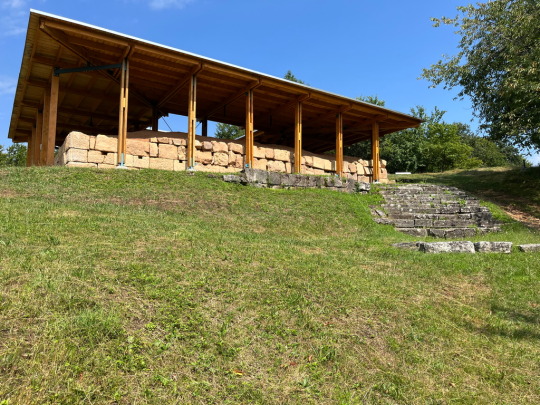




Costești-Blidaru
Im Dörfchen scheint alles auf Besucher der Daker-Festungen eingestellt, es gibt einen Campingplatz und Restaurants. Ich folge den ausgeschilderten Wegen eine Weile durch den Wald hinauf. Doch sie werden immer schmaler und die Spur verliert sich, so dass ich wieder umwende. Vielleicht gäbe es einen Wanderweg. Auf der Weiterfahrt am Fluss entlang entdecke ich einen weiteren Zugang zu Fuß, doch da gibt es unten keinen Parkplatz. Auf alle Fälle ist hier aber eine wunderschöne Wandergegend, ganz unabhängig von den Daker-Spuren, merke ich mir vor.


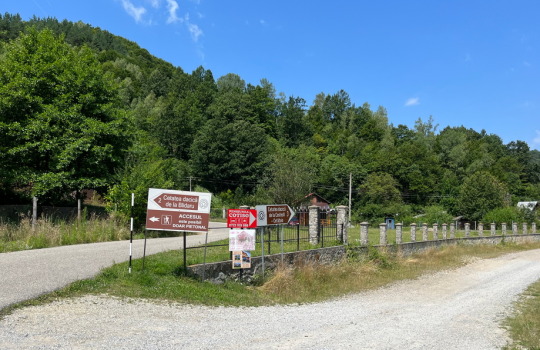
Sarmizegetusa

Sarmizegetusa war ehamals die Hauptstadt des Dakerreichs.
Die Stätte ist schon weithin ausgeschildert und ich fahre eine Stunde durch ein spektakuläres Bergpanorama, bevor ich schließlich auf den großen Parkplatz einbiege.

Den Besucher erwartet ein sehr großes Gelände und schon bald entdecke ich verzierte Säulen, Tempel, Wohn- und Handwerkergebäude. In der Stadt haben einst 20 bis 30.000 Menschen gewohnt.



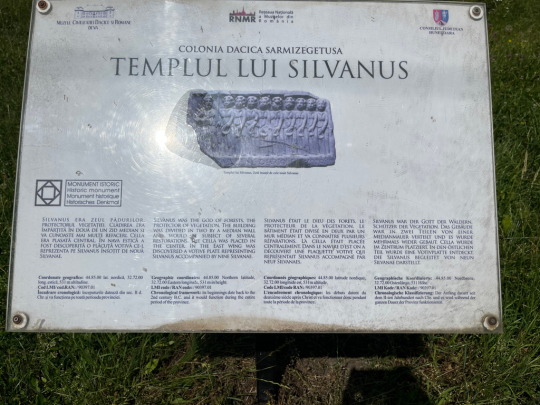




Ich durchstreife und umrunde das Gelände, gleich neben den Tempeln wächst Mais und ein Bauer hat sein Gehöft eingezäunt.
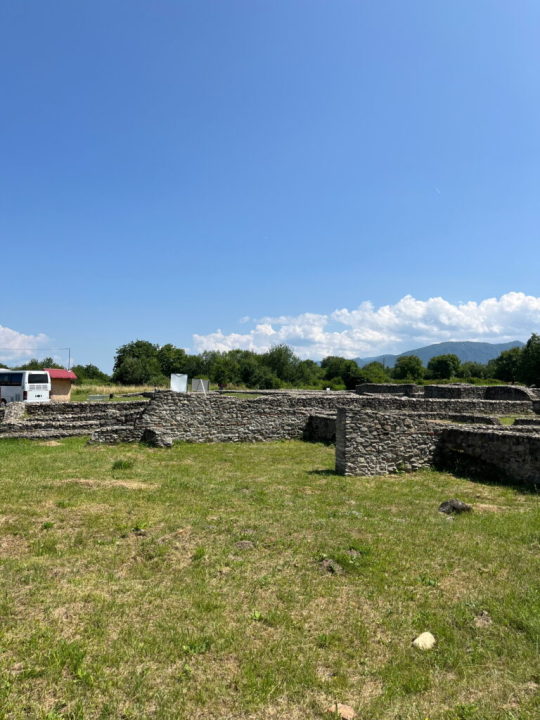
Direkt neben der äußeren Mauer hat eine Sanierungsfirma ihr Baumaterial gelagert.
Trotz eines Hotels und großer Restaurants scheint der ganze kleine Ort ein bisschen aus der Zeit gefallen.
In einem Haus auf der anderen Straßenseite ist das Museum untergebracht und ich besuche zum Abschluss die kleine, aber wirklich interessante Ausstellung im Vorgarten.








Resümee
Alle, die sich für die antike Geschichte interessieren, sind bei den Dakischen Festungen im Orăștie-Gebirge richtig. Ich kann mich nur wiederholen - ich habe größte Achtung vor dem, was die Archäologen den alten Mauern an Informationen entnehmen und lese immer mit Interesse die Beschreibungen. Die Festungen im Wals aufzuspüren, ist ein kleines Abenteuer. Aber auch wer tolle Natur erleben und durchwandern möchte, findet hier schöne Urlaubsorte mit wunderbarer Umgebung.
Die gesamte Tour go-south 2.0 ist hier beschrieben. Hier gehts zu meinem Welterbe-Projekt. Der Umbau meines Dacia Dokker als Minicamper ist hier detailliert nachzulesen. Dobbys nach und nach angepasste Einrichtung und Ausstattung hat sich auch in diesem megaheißen Sommer bewährt. Meine Übernachtungsplätze habe ich wieder auf park4night gesucht und unter 5Reisende bewertet.
Read the full article
#Abenteuermobil#Abenteuerreise#alleinunterwegs#Alleinreisen#Ausbau#Ausrüstung#Autoreise#Besichtigung#Camping#Camping-Mobil#Dacia-Dokker#Daker#DIY#Dobby#Dracula#Erfahrungsbericht#Erkundung#Europa#Festungen#Hochdach-Kombi#Inspiration#Leichtbau#Minicamper#Orastie-Gebirge#Parkplatz#Reisebericht#Reisefotografie#Reisetagebuch#Reiseziele#Roadtrip
0 notes
Video
youtube
Sketching Densus church - September 2023
Architectural sketching of the 11th - 14th c built Densus church in Hateg Country, SW Transylvania. The church is a succession of phases from the Romanesque to the early Gothic styles, crowned with a Rhenish helm atop its bell tower. It is famous for the reuse of bits of a Roman temple that once stood there and spolia from the nearby Roman colony Ulpia Traian Sarmizegetusa, the capital of the province of Dacia.
0 notes
Photo

PEREN Regia Automatic Timepieces: Inspired By The Sarmizegetusa Regia Calendar
Nice.
Follow us for more Tech Culture and Lifestyle Stuff.
0 notes
Text
Bare Bones, Exploring the Rare and Old Densuş Church
Looking at bare bones, exploring rare & ancient Densuş Church where Roman columns mix with Dacian beliefs, tombstones, and Romanesque influences. Myth & legend!#Im4Ro
I love to discover the bare bones of an old church and the rare and ancient Densuş Church is a treat!
The enigmatic Densuş Church is located at a short distance from Ulpia Traiana Sarmizegetusa, once the heartbeat of the sprawling Roman Empire in Dacia. Its eons-old presence calls like a closely kept secret, attracting the interest of historians worldwide… Because within its revered walls is a…
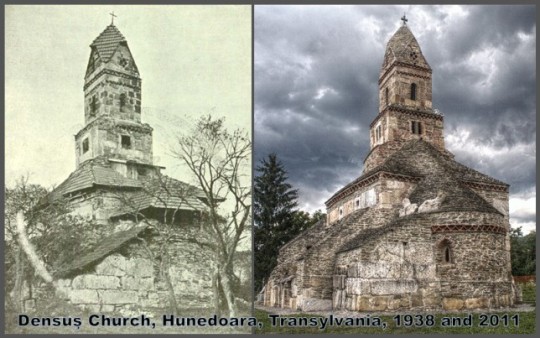
View On WordPress
0 notes
Text
O nouă descoperire uimitoare la Sarmizegetusa Regia: Ce au găsit arheologii UBB?
Arheologii care efectuează lucrări de restaurare și cercetare la Sarmizegetusa Regia au anunțat recent o nouă descoperire uimitoare. Conform unui anunț al Facultății de Istorie și Filosofie din cadrul Universității Babeș-Bolyai (UBB), „pe parcursul cercetărilor […]
Articolul O nouă descoperire uimitoare la Sarmizegetusa Regia: Ce au găsit arheologii UBB? apare prima dată în Descopera.
Această…
View On WordPress
0 notes
Text
În adâncurile vremurilor străvechi,
Pe pământurile blânde ale Traciei,
Geto-Dacii și-au clădit imperii,
Cu voință și credință în sângele lor vii.
Trăind în armonie cu natura,
Viteji și înțelepți, demni de cinste,
Geto-Dacii vegheau asupra patriei,
În inimi strălucea mândria și voința cea fierbinte.
Pe plaiurile vrăjite ale Carpaților,
Răsunau ecouri de război și cântec,
Tracii viteji înfruntau orice tiran,
Aparau cu demnitate sacrele lor legi și drept.
Sacredul Sarmizegetusa se înălța,
Cetatea de piatră și spirit nemuritor,
Un loc sfânt în care zeii coborau,
Să vegheze asupra poporului celor de sub soare toritor.
În poezii străbatem hoinării prin timp,
Descoperim trecutul pierdut și sfințit,
Duhul Geto-Dacilor trăiește în versuri,
Cu mândrie și dragoste de neamul născut.
Tracia, leagăn al unui popor înălțat,
Cu cultura bogată și tradiții sfinte,
Geto-Dacii trăiesc în spiritul nostru,
Ridicând înălțătoare steaguri de tinerețe.
Astfel, prin poezie și cuvânt ne aducem aminte,
De strămoșii ce-au scris pagini de aur,
Geto-Dacia și Tracia se împletesc în cântec,
O eternă poveste de iubire și onor.
0 notes
Note
Hi! I think you're the resident Tzimisce lore expert and I am only a wiki reader, so I was wondering if you had any thoughts on Lambach Ruthven? Just going off of what I've read he seems pretty interesting as someone who's been relegated to an observer role despite his ambitions, but I think you'd have more information from context and tone
Oh, he's definitely an interesting character! First is the question of generation, since either there were mistakes made, or there's some diablerie going on. Here's what we know:
Lambach is assumed to be 5th generation, childe of Tabak.
Tabak, by inference, is 4th generation by the time he Embraces Lambach (supposedly some time around 1100).
Dracula forces Lambach to Embrace him, making him 6th generation initially, then diablerises Tabak, making him the same as his sire Lambach, 5th.
Except in the DA novel, Tabak Ruthven is the childe of Damek Ruthven. Damek is 5th generation, making Tabak 6th; this also matches with Damek being the sire of Danika Ruthven, also 6th.
We know that a character named 'Lord Ruthven' is a 4th generation childe of the Eldest.
Tabak can't actually be Lord Ruthven, he's explicitly the childe of Damek Ruthven. So my best assumption is: Lord Ruthven is Embraced by the Eldest (4th). Lord Ruthven Embraces Damek (5th). Damek Embraces Tabak and Danika (both 6th). Tabak then goes on a minor diablerie spree and munches his way down to 4th, and Embraces Lambach (newly 5th). This does present the interesting scenario where, when Myca and Ilias visit Damek (and Tabak) in the novel in around 1233, Tabak is already 4th generation and lower than his 5th-gen sire, Damek.
Twisty! It works, but twisty! And honestly, it's kind of fitting that a serial diablerist's fate is to end up being diablerised himself, right?
Anyway, back to Lambach. It is a tricky question here, because there are in-universe rumours he's the childe of the Eldest himself. He's described as a grandchilde of the Eldest (matching 5th gen) in the Gehenna book, in Nights of Prophecy, and via Dracula's generation. He's described as potentially the childe of the Eldest by an in-character account in the Revised Tzimisce Clanbook, so 4th, and as 7th in Encyclopedia Vampirica, although those are in-character accounts and could well be suspect.
(Interestingly, if Tabak really was the childe of Damek, childe of Lord Ruthven, childe of the Eldest, without diablerie taking place, then yeah, Lambach genuinely would be 7th. EV lists him as 7th gen and childe of Damek; interestingly, Dracula (under Vlad Tepes) is listed both as 5th gen and as the childe of Lambach, so clearly either they couldn't reconcile the information or the characters missed that inconsistency.)
Generation aside, Lambach does seem to be the figure of rumour and hearsay far more than actual fact. He's the childe of the Eldest! No wait, he's the childe of Tabak! He's fourth gen, fifth gen, seventh gen! He's a bumbling fool who the Eldest keeps around as a court jester, he's the Eldest's chronicler, he's a genius mastermind and is behind everything from the Anarch Revolt to Yorak being eaten by his own haven! He's supposedly trapped in Poenari Castle; no wait he's escaped New York and is now hiding with Prospero in the Caymans!
My take on Lambach: he was Embraced by serial diablerist Tabak as 5th generation (after Tabak had lowered his generation from 6th to 4th), in around 1100. Due to his sire residing in Sarmizegetusa, he had basically grown up around the God-Tree, the Eldest's current form, and a connection had grown between them. The Eldest kind of saw him a bit as an interesting pet, basically. The Eldest allowed Lambach to see the truth behind Lugoj 'diablerising the Eldest' as a way to say, "I trust you to keep my secrets, but no one will ever believe you :)" Once the Eldest was taken to New York, Lambach managed to stay away, being forced to Embrace Dracula etc, basically being influenced by the Eldest to be there for all these pivotal events in Tzimisce history but not really able to affect them.
When he's summoned to New York around the turn of the millennium, he stays for much longer than Nights of Prophecy implies; following BJD, he's there for a while, serving the Eldest, feeding people to them, and gradually being 'a good lad'. He doesn't want to disobey his grandsire, now! Eventually, he does manage to escape (minus an arm, it's fine, he's a Tzimisce) and makes it to the Caymans, where he speaks to Beckett and tells him just what's underneath New York. He's a mess of trauma and poor coping skills, currently free, but who knows how long that will last? Certainly not Lambach!
Last up, I'm going to include this fun little account from the Revised Clanbook Tzimisce. The quality of the cap I have is terrible so I'll just type it up:
"Lambach Ruthven is fairly righteous, but part of me thinks he's been smoking crack out of babies' asses. I got a look at his precious journal when he wasn't around, and there's some wild shit in there. He claims he saw Lugoj Blood-breaker commit Amaranth on the Eldest itself before the Antediluvian went ahead and pulled a fast one on him. That means that Lugoj, who's in torpor somewhere in the Carpathians, is actually Tzimisce now. All right, cool, whatever. Later, Lambach tells me the Eldest's a mutated fucking patch of out-of-control cannabis living beneath New York and spreading through the sewers like a weed. I know, to you this sounds like moist and runny shit, but you got to respect the fact that we can do some scary-ass stuff. Lambach's tale means one of two things. One, he took a big hit off that baby butt, or two, the legends our sire told us were true.... What?? You know which one. I'm talking about where Tzimisce can manifest in any of us and turn us into it. If that's true, then there's at least two Tzimisce Antediluvians running around right now, and we're doubly screwed. What? What d'ya mean "Be a good lad"? What the fuck are you talking.... Holy shit -"
-Kaleel Bratovich, Tzimisce kennel master, deceased
What a clan :)
14 notes
·
View notes
Text
About România - Rumänien als ultimativer Tipp für den Urlaub
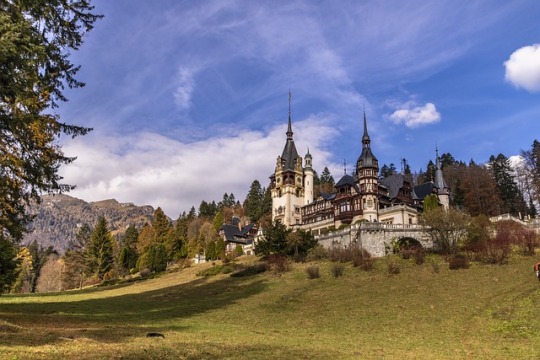
Rumänien ist ein Land, das viele Reisende oft übersehen. Doch das Land hat so viel zu bieten, von den malerischen Bergdörfern bis hin zu den faszinierenden Burgen und Schlössern. Hier sind einige Gründe, warum Rumänien definitiv ein Urlaubsort sein sollte.
Rumänien hat eine faszinierende Geschichte und Kultur
Rumänien hat eine reiche Geschichte, die sich in der Architektur, den Traditionen und den Bräuchen des Landes widerspiegelt. Die rumänische Kultur ist eine einzigartige Mischung aus römischen, slawischen, deutschen und ungarischen Einflüssen. Das Land hat viele wunderschöne Burgen und Schlösser, die auf verschiedene Epochen zurückgehen, darunter das berühmte Schloss Bran (hier noch ein schöner Artikel dazu), auch bekannt als Draculaschloss, sowie das beeindruckende Schloss Peleș in Sinaia.
Einzigartige Natur
Rumänien hat auch eine einzigartige Natur. Das Land hat eine malerische Landschaft mit malerischen Bergdörfern und unberührten Wäldern. Der Nationalpark Retezat bietet zahlreiche Wanderwege, die zu atemberaubenden Berggipfeln und Bergseen führen. Auch die Donau Delta, das größte Flussdelta Europas, ist ein beliebtes Reiseziel für Vogelbeobachtungen und Bootsfahrten. eine Wanderung zum Pietrele Doamnei (s.u.) lohnt ebenfalls.

Pietrele Doamnei in Rumänien
Kulinarische Köstlichkeiten
Die rumänische Küche ist ein Schmelztiegel der verschiedenen Kulturen und Traditionen. Die Gerichte sind oft deftig und reichhaltig und basieren auf Fleisch, Fisch, Gemüse und Teigwaren. Eine der bekanntesten rumänischen Spezialitäten ist Sarmale, gefüllte Kohlblätter mit Fleisch und Reis, die oft mit saurer Sahne serviert werden. Eine weitere beliebte Delikatesse sind Mici, kleine, gegrillte Würste aus Lamm- oder Rindfleisch, die oft mit Senf und Brot serviert werden.
Bezahlbarer Urlaub in Rumänien
Rumänien ist auch ein erschwingliches Reiseziel. Die Kosten für Unterkunft, Essen und Transport sind im Vergleich zu anderen europäischen Ländern oft niedriger. Es gibt eine Vielzahl von Unterkunftsmöglichkeiten, von einfachen und günstigen Pensionen bis hin zu luxuriösen Hotels. Auch die öffentlichen Verkehrsmittel sind günstig und bieten eine einfache Möglichkeit, das Land zu erkunden.
Vielfältige Aktivitäten
Es gibt viele Aktivitäten, die man in Rumänien unternehmen kann. Neben Wandern und Vogelbeobachtungen im Nationalpark Retezat oder im Donaudelta kann man auch in den rumänischen Karpaten Ski fahren oder Snowboarden. Im Sommer kann man in den Bergen auch Mountainbiken oder Paragliding ausprobieren. Für Kulturliebhaber gibt es viele Museen und historische Stätten zu besichtigen, darunter das beeindruckende Kloster Putna oder das antike römische Amphitheater in Ulpia Traiana Sarmizegetusa.
Fazit
Rumänien ist ein Land, das oft übersehen wird doch es hat so viel zu bieten und ist definitiv einen Besuch wert. Entdecke die faszinierende Geschichte, die einzigartige Natur, die köstlichen kulinarischen Köstlichkeiten und die vielfältigen Aktivitäten, die Rumänien zu bieten hat. Lass dich von diesem charmanten Land begeistern und erlebe einen unvergesslichen Urlaub.
Read the full article
#Delikatesse#Dracula#Essen#Europa#Geschichte#günstig#Hotel#Kultur#Land#Natur#Pension#România#Rumänien#Schloss#Tipp#Tipps#Urlaub#Wandern
0 notes